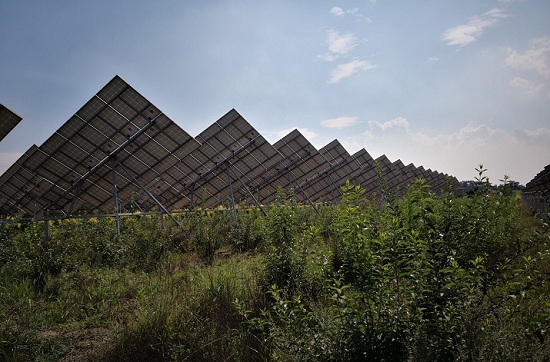北京周报:光伏产业升级为煤矿沉陷区带来希望

A demonstration base of China's photovoltaic industry in areas of Datong afflicted by coal-mining subsidence, established by SPIC and connected to the grid on June 18, 2016 (ZHANG SHASHA)
Strolling along lanes lined with lush vegetation, decorated sporadically with clusters of sunflowers, it is hard to imagine that the surrounding land on which a garden-like new energy power station now stands was once ravaged by mining, left pockmarked and barren by the long-term and high-intensive extraction of coal.
Datong, a city in north China's Shanxi Province, is regarded as China's capital of coal and has long been a crucial source of the country's energy. However, the exploitation of the region's natural resources has led to a 1687-square-kilometer area of subsidence, or unstable ground as a result of mining activity. Thousands of houses have collapsed as a result, and farmland in some places has been degraded to the extent that residents were left with no choice but to move.
"Coal-mining subsidence is present in around 12 percent of Datong's total area," said Ma Anquan, the Deputy Mayor of Datong, adding that ecological restoration is a tough challenge.
In order to tackle the issue, the government proposed the development of the photovoltaic (PV) industry in the area while growing plants beneath the PV modules so as to rejuvenate the land. The move is conducive to transforming Datong's coal-dominated energy structure, encouraging the city's transition following the exhaustion of its resources and, more importantly, upgrading China's PV industry itself.
On June 25, 2015, the Datong coal-mining subsidence program became the first demonstration base with advanced PV techniques to be approved by the National Energy Administration (NEA) as part of the "Top Runner" program for the PV industry.
According to the NEA, the program aims to apply the technology and experience harvested from demonstration bases such as the Datong program in other PV projects, so as to facilitate the development of cutting-edge technology, lower costs, reduce corporate reliance on government subsidies and promote high-quality development.
"We have chosen five types of stands, both fixed and adjustable, and by designing the matrix according to solar conditions and geomorphic features, we are exploring an optimized plan to maximize efficiency, " said Liu Chengkui, chief representative of the Taiyuan Representative Office of China Power International Limited, a subsidiary of the State Power Investment Corporation (SPIC), adding that practical data of each type would be recorded to see which can achieve better results, benefitting the whole industry.
As the first among 13 elected companies to connect to the grid, and the highest ranking in terms of technical indicators, SPIC won the bid for the second phase of the Datong "Top Runner" program which began on June 29 and is expected to finish before November 30 this year, accounting for 80 percent of the total PV quota.
Liu concluded that "improving PV technology and reducing costs are both crucial to improving the core competitiveness of PV corporations and weaning them off government subsidies."
"Now, the PV industry needs to attach more importance to improving quality and efficiency and promoting technological development rather than scaling up further," said Li Chuangjun, deputy head of the New Energy and Sustainable Energy Department of the NEA, "this should be the basic ethos for the development of the PV industry in the years to come."
Copyedited by Laurence Coulton
Comments to linan@bjreview.com